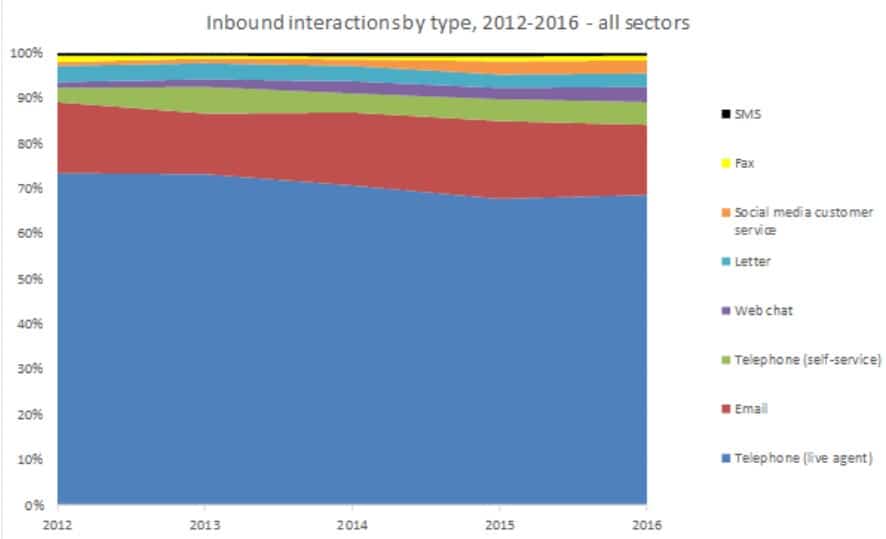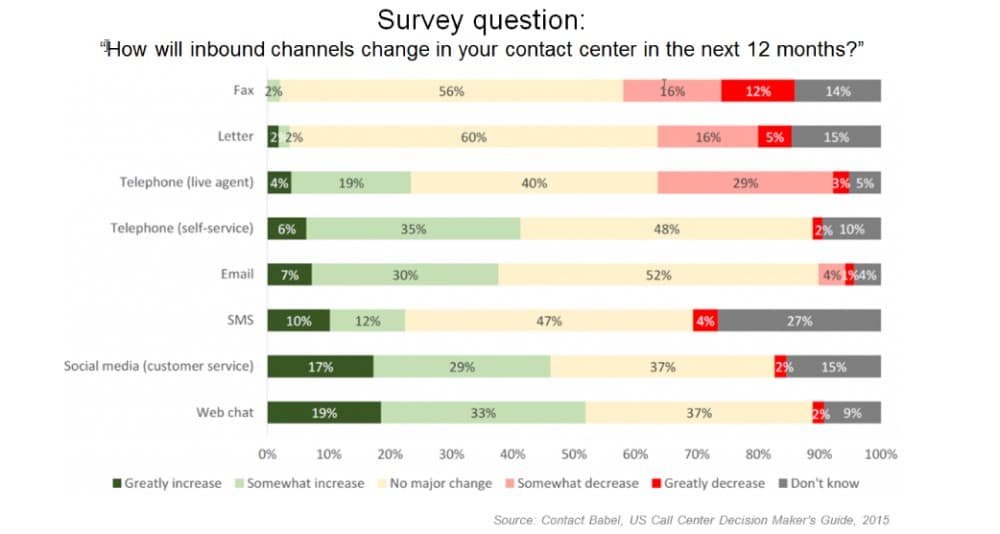This is the second post of a RingCentral series that is focused on the call centre industry. We’ve spoken to industry experts to explore all the vital elements of the niche. In our first post, we took an overview of contact centres and – particularly – the agents who make them tick. Now, we’re going to discuss one of the crucial tasks they undertake – call handling.
Today’s contact centres use several channels of communication. Agents speak with customers via live chat, email, social media, and more. But often it is still telephony that forms the bulk of a call centre employee’s workload. The calls that agents deal with fall into two primary categories. They can be either inbound or outbound calls.
In this post, we’re going to explain the nature and challenges of each type of call. We’re also going to look at how the calls that centres typically handle are split between the two varieties. Finally, we’ll cast an eye to the future. We’ll consider whether the balance of inbound and outbound will change over time.
Inbound & Outbound Calls
The principle difference between inbound and outbound calls is self-explanatory. Inbound calls get made by customers to a call centre. Outbound calls get made by agents at the contact centre to customers. That fundamental difference has a significant impact on the nature of each type of call.
Inbound calls are primarily associated with customer service. When a customer gets in touch with a call centre, they’re looking for answers or solutions to problems. In the case of inbound calls, therefore, agents must play a range of roles.
For many inbound contacts, agents provide tech support, solving issues related to orders, accounts, and other admin. They’re there to deal with customer inquiries. They must also be able to overcome particular problems.
Outbound calls, on the other hand, are often related to sales. Most outbound agents work through a database of contacts, trying to sell a product or service to the leads. In many ways, outbound calls are a lot simpler and more repetitive than the inbound variety. In an outbound contact centre, agents are often very target focused. Their success gets judged on the number or value of sales.
Outbound calls don’t have to be sales-related, though. There is room for outbound calling in customer service. Phoning customers to help them with issues is a way to make customer service more proactive. It’s an avenue that experts believe call centres may explore more over time. As a concept, it fits with the idea of focusing more on customer experience than customer support.
We’re going to take a closer look at the idea of proactive outbound calling a little later. That’s as part of our look ahead at how inbound vs. outbound calling may change in the centres of the future. For now, though, let’s examine the situation as it is in 2020.
The Balance of Inbound Vs. Outbound in 2020
A 2017 report into UK call centres shared some insights into inbound and outbound calls. According to the study, outbound calling activity across the sector stands at 21.4%. That represents a drop of more than 12% over the 13 years since 2004. The research also states that despite the fall, more service focussed outbound calls are getting made.
Those findings line up with what we learned when we spoke to industry experts. Both Cymphony and FM Outsource reported that they primarily provide inbound services. Jack Barmby, Founder of FM Outsource estimated that as much as 90% of their current activities were on the inbound side. The reason for this skew is down to client demand. The experts from both contact centre operators stated that it was inbound which the majority of their clients were focussed on.
As well as inbound calls, contact centres also deal with contacts from many more channels. Email, live chat, and social media are amongst the most common. The report cited above suggests that around 15% of inbound interactions to centres are via email.

Source: Contact Babel
For Cymphony, the balance is a little different. Voice calls currently still account for 92% of their revenue. There’s no doubt, though, that omni-channel support is a developing trend in the industry. We’re going to look at that trend in more detail in a later post. What’s worth examining here is how new channels may impact both inbound and outbound calling.
The Future of Inbound Vs. Outbound Calling
In the past, a customer’s only option for support was to pick up the phone and call a service agent. Those times are gone. Today, most businesses offer email, live chat, and other channels to consumers.
One visible effect that this has is to reduce the volume of inbound calls to a contact centre. There are other ways, though, that multi-channel support impacts telephony in call centres.
According to the experts we talked to at FM Outsource, inbound activities are evolving. They’re increasingly getting driven by the channels which customers wish to use. That’s as opposed to those which clients or centres themselves may prefer.
Telephony is now an inbound channel that’s used in concert with many others. That makes integration of those channels vital to customer experience. We’ll talk more about that, though, when we focus on omni-channel support.

Source: Fonolo
Jack Barmby from FM Outsource also predicts that the greater variety of inbound channels may impact outbound calling. Specifically, they believe that there may be an upturn in service-related outbound calls. That’s especially phone calls to customers using other channels.
Anyone for proactive outbound calling?
Take, for instance, a customer interacting with a company via a messenger chat or email. If an exchange isn’t going as that customer hopes, they may become frustrated or angry. Receiving one more unsatisfactory message might push them over the edge. They could choose to abandon the entire support process.
If an agent anticipates a problem, they can pick up the phone and call the customer. It’s far easier for an advisor to show sympathy with someone on the other end of the phone than in a text conversation. Moreover, a phone call can resolve an issue faster than an email exchange might.
Some live chat channels do, of course, also give customers the option to escalate to a voice call. A link or button lets them choose to contact an agent if they get frustrated. Many customers, though, are more likely to abandon the process entirely once they reach peak frustration. The beauty of an outbound call is that it can pre-empt that scenario.
You’re also able to exchange more information faster on a call than via email or chat – that aids better understanding of an issue and a speedier resolution. What’s more, the act of calling a customer shows them that the agent – and the brand they represent – cares. Consumers who feel that way about a business are more likely to stay as a customer of that business.
FM Outsource are excited about the prospect of proactive outbound calling. They’re promoting the use of such tactics as a further way to deliver a quality-led service. What’s more, they also feel that they’re not alone.
One of the experts we talked to sees an industry-wide will to move toward more proactive outbound contacts. He believes that in the long-term, the rewards greatly outweigh the drawbacks. Calling a customer does take longer than sending an email. Resolving an issue in one call, though, means a customer won’t need to keep reaching out.
Inbound Vs. Outbound – The Evolving Balance of Call Centre Telephony
Inbound and outbound calls are vital elements in the operation of any contact centre. But the two strands of call centre telephony are often seen as distinct and separate. Inbound is about customer service, while outbound regards sales. Inbound, too, is the type of call more prevalent in a traditional call centre.
However, as with many things in business, the situation is actually fluid. In the future, calls look set to become better integrated within omni-channel platforms. That could see proactive, outbound customer service calls rise in prominence. Taking the lead and calling customers who use other channels is a win-win for contact centres. It aids customer satisfaction and helps resolve issues more efficiently.
A shifting balance between inbound and outbound calls is only one way that call centres are evolving. One of the most significant drivers of that evolution is the emergence of new technology. That’s the focus of the next post in our series.
Originally published Jun 02, 2020, updated Jan 16, 2023
